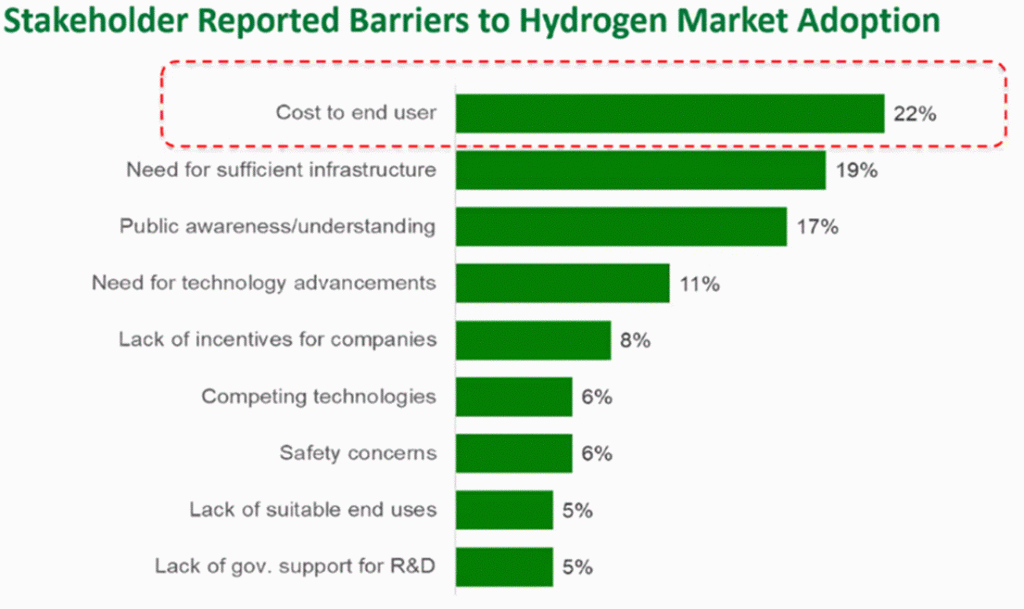H2 Rainbow – Is there a pot of gold at the end?

In 1972, John Bockris was the pioneer in introducing the concept of the “Hydrogen Economy,” envisioning a future where hydrogen serves as a sustainable substitute for fossil fuels. This groundbreaking article subsequently gave rise to the term “Green Hydrogen,” which found its way into numerous publications across various industries. Over time, the terminology surrounding hydrogen has diversified, forming a rainbow of colors. While there is no universally agreed-upon set of definitions for the colors within this hydrogen rainbow, some widely employed descriptions exist:
- Grey H2 – Hydrogen produced with traditional production techniques from hydrocarbon feedstock (e.g. methane, natural gas, LPG, light naphtha) in a steam methane reformer (SMR); currently, this is the most common form of hydrogen production
- Brown H2 – Hydrogen generated via coal using gasification technologies
- Blue H2 – Hydrogen produced with traditional production techniques, but installing carbon capture and sequestration (CCS) technology to capture (typically 80% to 90% being captured) and store the Green House Gases (GHGs); this is often referred to as low carbon
- Turquoise H2 – Hydrogen produced through methane pyrolysis to produce hydrogen gas and solid carbon; to date, this technique has not been developed at a commercial scale
- Green H2 – Hydrogen produced by splitting water into hydrogen and oxygen via electrolysis, and powering the electrolysis by renewable electricity sources, such as wind or solar
- Yellow H2 – Hydrogen produced by splitting water into hydrogen and oxygen via electrolysis, and powering the electrolysis by solar electricity sources
- Pink / Purple H2 – Hydrogen produced by electrolysis, but powered by nuclear generated electricity
- White/Gold H2 – Hydrogen that is naturally occurring
In 2022, the Department of Energy (DOE) announced “with $7,000,000,000 in funding through the Bipartisan Infrastructure Law, the H2Hubs will be a central driver in helping communities across the country benefit from clean energy investments, good-paying jobs, and improved energy security.” To many individuals and companies, this represents a substantial potential “Pot of Gold.” Are these opportunities turning out to be as rewarding as envisioned?
Background
The US National Clean Hydrogen Strategy Roadmap, notes “The 2020 baseline cost of $5/kg is the levelized cost of hydrogen calculated using DOE’s H2A model using a conservative $1,500/kW for PEM electrolyzer capital cost (at low volume manufacturing), a $50/MWh electricity price, and a capacity or utilization factor of 90 percent. In comparison, using today’s $29/MWh for solar and 35 percent capacity factor, based on the 2020 National Renewable Energy Laboratory (NREL) Annual Technology Baseline, results in a levelized hydrogen cost of about $7.50/kg… The example shown of what would be needed to achieve $2/kg – required by the BIL by 2026 – is based on $30/MWh energy costs and $300/kW capital costs, and the $1/kg Hydrogen Shot goal would require $20/MWh and $150/kW, respectively. These cost targets do not include the clean hydrogen production tax credit.” DOE has also identified the following key factors as barriers to the market readily adopting hydrogen as a fuel.

To support resolutions to the above barriers, on October 13, 2023, DOE announced the seven Regional Clean Hydrogen (H2) Hubs that are to be funded as part of the Bipartisan Infrastructure Law (BIL). In my previous blog DOE Has Identified The Regional Clean Hydrogen Hubs – What Are The Next Steps? I provided additional details about these seven H2Hubs. These hubs “…will kickstart a national network of clean hydrogen producers, consumers, and connective infrastructure while supporting the production, storage, delivery, and end-use of clean hydrogen. “Collectively, the H2Hubs will create tens of thousands of good-paying jobs across the country. Each Hub will have unique benefits like: reduction in air pollution (e.g., particulate matter), for example by replacing diesel trucks with fuel cell vehicles; remediation of legacy pollution by cleaning up legacy sites that will serve as production or end use facilities; investment in education and workforce development; creation of quality, permanent, local jobs; enterprise creation; equity partnerships; and energy resiliency. “
On December 26, 2023, the Internal Revenue Service (IRS) finally issued for comment “Section 45V Credit for Production of Clean Hydrogen; Section 48(a)(15) Election To Treat Clean Hydrogen Production Facilities as Energy Property.” This guidance would allow the tax credit to be worth as much as $3/kg of hydrogen produced over a ten year period.
Current Regional Clean Hydrogen Hub Key Activities
My previous blog provided an overview of the key milestones involved:
- Winter 2023-2024 – Award negotiations
- Phase 1: 2024-2026 – Detailed planning (12-18 months)
- Phase 2: 2025-2029 – Development, permitting, & financing (2-3 years)
- Phase 3: 2028-2033 – Install, integrate, construct (2-4 years)
- Phase 4: 2030-2037 – Ramp Up & Operate (2-4 Years)
The award negotiations are underway; but, it is envisioned that IRS 45V Tax Credit Draft Guidelines, when finalized and issued, will have a significant impact on the negotiations.
Current IRS 45V Tax Credit Guideline Key Activities
Written or electronic comments for the guideline must be received by February 26, 2024. The public hearing on these proposed regulations is scheduled to be held on March 25, 2024.
Below is an overview of the guideline:
- “Incrementality – Proposed rule: New clean electricity must be placed in service less than 36 months prior to the hydrogen facility being placed in service.
- Temporal Matching – Proposed rule: Clean electricity and clean hydrogen production can be annually matched until 2028. Starting on January 1, 2028, projects must match clean electricity and hydrogen production at an hourly level.
- Deliverability – Proposed rule: Clean electricity must be generated in the same DOE Grid Congestion Zone as the hydrogen production
- GREET – Clean hydrogen technologies are still innovating – the hydrogen rainbow continues to grow and GREET will need to evolve to keep up with innovation (emerging technologies: electrolyzers, pyrolysis, natural hydrogen)”(5)
NOTE: GREET is the Greenhouse gases, Regulated Emissions, and Energy use in Transportation model developed by the Argonne National Lab.
Since the guidelines were issued, there have been numerous articles written about those guidelines.
To date, the comments generally fall into one of the following two areas: activists want tax incentive reserved for new, clean power; and, advocates say restrictions could suppress industry’s promise. An example of the former is the proposal for clean hydrogen tax credits is built on “three pillars” that will ensure hydrogen actually fights climate change instead of making it worse. An example of the latter is plans by Baltimore-based Constellation Energy to mass produce carbon-free hydrogen could be jeopardized under proposed federal guidelines that exclude existing nuclear plants from tax subsidies designed to boost a budding clean hydrogen industry.
A general consensus is that the guidelines are complex and may be confusing to the general population and industry representatives. In addition, comments have been made stressing that the IRS needs to assure these credits need to be coordinated with other possibly applicable current tax credits.
Summary
At the present time, no one knows what the pot at the end of the hydrogen rainbow will include. It is uncertain if it will fulfill the hopes of those individuals and organizations that are actively working to help the U.S. achieve the administration’s goals of:
- A 50% to 52% reduction in U.S. GHG emissions from 2005 levels by 2030
- 100% carbon pollution-free electricity by 2035
- Net zero GHG emissions no later than 2050
- 40% of the benefits of federal climate investments delivered to disadvantaged communities.
The implementation of H2Hubs concept and the final versions of guidelines will be key elements in determining how successfully those goals will be met.
In a Becht presentation (“Hydrogen Economy Production, Uses, Options, and Challenges,” November 2022; presented by M C Annon and R Ohmes), it was noted that “In the near term, Blue Hydrogen provides a technically and economically viable opportunity to begin the energy transition”; and, that in “Longer term, Green / Pink / Turquoise Hydrogen must achieve scalable operation to help attain net zero initiatives.”
In the future, Becht will provide blogs with the pertinent information as:
- Guidelines evolution
- H2Hubs milestones progress
- Other relevant announcements made and/or key achievements.
- Hydrogen rainbow associated technologies.

